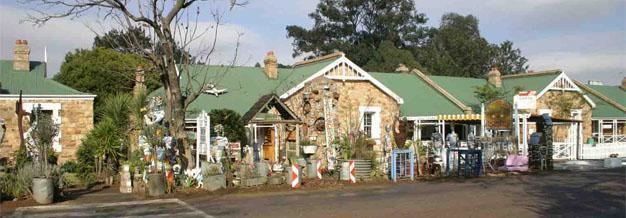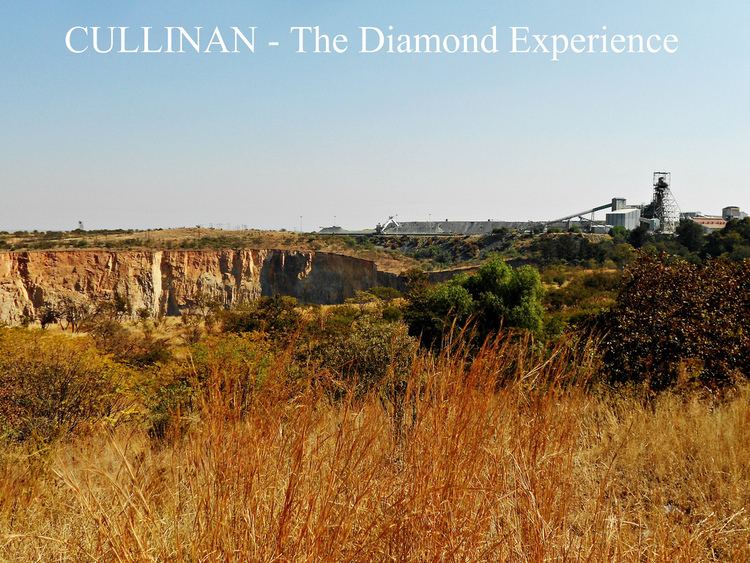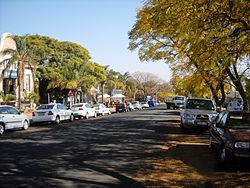Country Area 55.66 km2 | Language spoken Afrikaans Founded 1903 | |
 | ||
Points of interest Premier Mine, Willem Prinsloo Agricultural Museum, Rietvlei Nature Reserve | ||
Map of Cullinan, Gauteng
Cullinan is a small town 30 km (19 mi) east of Pretoria, Gauteng, South Africa. It is a small town along the diamond route that is heavily reliant on tourism and the mine that dominates the skyline. The town is named after diamond magnate Sir Thomas Cullinan.
Contents
- Map of Cullinan Gauteng
- Imperial toyota rally cullinan gauteng friday 15 august 2014
- Cullinan diamond mine cullinan town gauteng
- History
- Geography
- Government
- Tours
- Museums
- Adventure
- St Georges Anglican church
- Cullinan hospital
- Nedbank
- Masonic lodge
- References

Imperial toyota rally cullinan gauteng friday 15 august 2014
Cullinan diamond mine cullinan town gauteng
History

In 1898 Sir Thomas Cullinan was handed a three carat diamond found along a farm fence. He studied the area and came to the conclusion that the diamond was washed down from a nearby hill. Sir Cullinan made an attempt to buy the land from the owner, Joachim Prinsloo, but did not succeed. After Prinsloo's death, he was able to purchase the land for ₤52,000 from Prinsloo's daughter. The Cullinan kimberlite was discovered in 1902 and in 1903 open pit mining commenced. The mine was named the Premier mine.

On 25 June 1905, the famed Cullinan Diamond, the largest in the world at 3,106 carats (621.2 g), was discovered by Frederick George Stanley Wells, surface manager of the Premier Diamond Mining Company. It was bought by the Transvaal government and presented to King Edward VII.

The town of Cullinan owes its existence to the diamond mining in this area, much like Kimberly in the Northern Cape Province of South Africa.
Geography
Cullinan is situated in the Highveld region of South Africa. The town has an elevation of 1476 m (4842.52 ft) and is located at -25.6709 [latitude in decimal degrees], 28.5236 [longitude in decimal degrees]. The closest city is Pretoria being 40 km (25 mi) away, while Johannesburg is 100 km (62 mi) away.
Government
Cullinan formed part of the Nokeng tsa Taemane Local Municipality until 18 May 2011. Due to mismanagement of funds, this municipality was disbanded and incorporated into the Tshwane Metropolitan Municipality.
Tours
Various operators offer tours around Cullinan. Tourists can choose between tours around town, within the mining area and even underground mining tours. Various means of transportation is used to provide these tours, the most popular being on an open vehicle or on foot.
Museums
There are a few museums in the area in and around Cullinan. A few of the most popular ones are:
Adventure
The mountainous terrain surrounding Cullinan offers multiple activities for more adventure-oriented people, like:
There is also an annual mountain bike race called the Cullinan Diamond Rush.
St. Georges Anglican church
The church was designed by British architect Herbert Baker, who was a dominant figure in South African architecture between 1892-1912. The church was built in 1904 as the parish church for the miners. The church is a simple square structure with a corrugated iron roof. The first recorded meeting was held on April 22, 1906.
Cullinan hospital
The hospital was built in 1907, and was officially opened by Annie Cullinan, wife of Sir Thomas Cullinan. It served only the European miners back then, but now serves the need of all the people living in Cullinan. The hospital has since closed down.
Nedbank
The Nedbank building was built around 1908. The building is still in use today by the bank.
Masonic lodge
The Premier Diamond Masonic Lodge was consecrated in the Cullinan School Hall and met there until 1909 when the new lodge building was completed at a cost of ₤1200. A feature of the Lodge's history has been the number of times it has been forced into recess, whether because of war, as in 1914 to 1916, disturbances leading to martial law, 1921 to 1922, and the closing down of the diamond mine (the main source of members) during the depression, 1932 to 1941. However the Second World War saw military forces stationed on the mine and an adjoining farm and this helped the lodge to get restarted. Then in 1945 the mine was reopened, restoring 'normality' to Cullinan, and since then the lodge's progress has been steady and sound. The lodge is still in use and looks the same as it did 100 years ago, having been preserved by active members.
